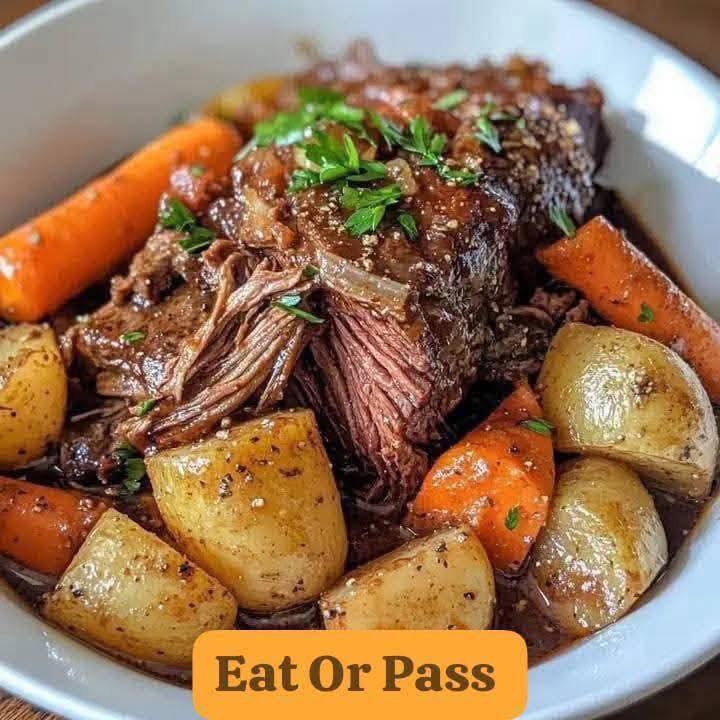Choosing the Right Cut
Opt for a chuck roast as it has the perfect balance of fat and connective tissue, which breaks down during cooking to create a tender and flavorful dish.
Marinating for Extra Flavor
For an extra depth of flavor, you can marinate the roast overnight in a mixture of beef broth, red wine, garlic, and herbs.
Searing for Depth
Don’t skip the searing step. It creates a Maillard reaction, enhancing the flavor and texture of the roast.
Layering Flavors
Sautéing the onions and garlic before adding the liquids ensures they release their full flavor, adding complexity to the dish.
Deglazing for Richness
Deglazing the pot with wine or broth picks up all the flavorful bits stuck to the bottom of the pot, which will enrich the braising liquid.
Slow Cooking
Low and slow is the key to a perfect pot roast. Cooking at a low temperature for several hours ensures the meat becomes melt-in-your-mouth tender.
Maintaining Moisture
Keeping the lid on the pot while cooking helps to trap the moisture and flavors, preventing the roast from drying out.
Checking for Doneness
Test the roast by inserting a fork into the meat; if it pulls apart easily, it’s done. Overcooking can cause the meat to dry out, so keep an eye on it towards the end.
Resting the Meat
Allowing the roast to rest before slicing ensures that the juices redistribute throughout the meat, making each bite juicy and flavorful.
Serving with Style
Present the sliced roast on a platter surrounded by the vibrant carrots and potatoes. Drizzle with the gravy for a stunning and appetizing presentation.
Tips
Choosing the Right Cut: The best cuts of meat for pot roast are large, tougher cuts such as chuck roast, brisket, or round. These cuts benefit from long cooking processes that break down the collagen, resulting in tender meat.
Don’t Rush the Searing: Take your time to sear the meat properly; this creates a flavorful crust that adds depth to your final dish.
Use Quality Broth: Using a good-quality beef broth will greatly enhance the flavor profile of your pot roast. If possible, make your own using beef bones and vegetables
Experiment with Herbs: Feel free to experiment with different herbs and spices, such as rosemary or Italian seasoning, to create a unique flavor profile that you’re fond of.
Preparation Ahead of Time: You can prepare some components of your pot roast in advance. Dice the vegetables the night before and store them in the fridge. This makes the cooking process much more efficient.
Low and Slow is Key: The longer you cook the roast at a low temperature, the more tender it becomes. Avoid cranking up the heat to speed up the process; patience leads to delicious results.
Resting Period: Let the roast rest for 15-20 minutes after it’s done cooking. This helps the juices redistribute through the meat, keeping it moist.
Leftovers Magic: The leftovers can be transformed into several dishes, such as pot roast sandwiches, beef stew, or a savory pot pie. The flavors often intensify even further the next day!
Check for Doneness: Use a meat thermometer to ensure that your roast has reached an internal temperature of at least 195°F – 205°F for the tenderest results.
Garnish Wisely: Adding fresh herbs like parsley or chives as a garnish right before serving can brighten up the dish and enhance its appeal.
Conclusion
In conclusion, cooking the perfect pot roast with potatoes and carrots is an art that combines technique and love. With the right ingredients, method, and a little patience, you can create a delicious meal that embodies comfort food at its finest.
The flexibility of pot roast means that you can easily make variations to suit your tastes or adapt it to seasonal ingredients.
Whether it’s a special family gathering or a quiet dinner at home, this dish has the power to warm hearts and create memories around the dinner table. Embrace the process and enjoy the comforting aroma that fills your kitchen as you prepare this beloved dish.
As you embark on making your own pot roast, remember that practice makes perfect. Don’t be discouraged by minor missteps along the way—instead, use them as learning opportunities to refine your culinary skills.
So gather your loved ones, prepare your ingredients, and enjoy the rewarding experience of cooking and serving a pot roast. Ultimately, it’s not just about the meal; it’s about the joy of sharing good food and good company. May your table be filled with love, laughter, and delicious pot roast for many years to come!
